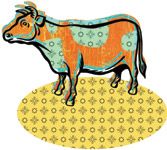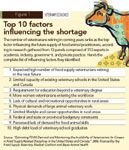Finding food animal veterinarians
Study data shows that for every 100 job openings, only 96 veterinarians will be ready to fill the spots.
REPORTS OF A SHORTAGE OF FOOD supply veterinarians are nothing new. But now, there's proof. "Estimating FSVM Demand and Maintaining the Availability of Veterinarians for Careers in Food Supply Related Disciplines in the United States and Canada," a 2006 study financed by the Food Supply Veterinary Medical Coalition and Bayer Animal Health, projects that demand for food supply veterinarians will increase 12 percent to 13 percent between now and 2016—and forecasts a 4 percent to 5 percent shortfall of veterinarians per year. In practical numbers, the study says that for every 100 job openings, there will be only 96 veterinarians to fill the positions.

"A shortage of food animal veterinarians has massive ramifications," says Dr. Jack Walther, the 2003-2004 president of the AVMA and president of the 2005 Western Veterinary Conference. "To give you some idea of how bad it's getting, 30 years ago five food animal veterinarians worked in my town—Elko, Nev. Today, there's one, and he works part-time."
Anatomy of the problem
Dr. Walther admits the economics and the care of food animals have changed dramatically over that time. Ranchers do much more herd health work themselves, he says, and have access to almost every drug a veterinarian does—cutting into what was a substantial income stream. In fact, Dr. Walther himself became discouraged that he couldn't offer the level of treatment he'd been trained to provide so he switched to companion animal practice.
In the FSVM study, which surveyed students and veterinarians in academia, industry, government, and private practice, respondents listed "less emphasis on food animal practice in veterinary colleges" as the greatest factor in the shortage. Student respondents also blamed perceived difficulties related to rural economies—poor income opportunities, few spousal career options, a lack of positive role models, limited lifestyle and career opportunities, and a lack of cultural and recreational opportunities all contributed to the overall problem. (See Figure 1)

Figure 1 Top 10 factors influencing the shortage
Interestingly, students' perceptions may not mirror actual conditions; food animal veterinarians studied expressed a high degree of career satisfaction—higher, in fact, than practitioners in other segments of the veterinary profession.
Shifting student population
"Rural folks make up an ever smaller part of the general population," says Dr. David Horn, an independent food animal consultant in Greenwich, N.Y., and one of the founders and a regional director for the Academy of Rural Veterinarians (ARV). (The ARV promotes rural veterinary practice through its Web site, www.ruralvets.com). "So we see more urban and suburban applicants entering veterinary school. And they naturally arrive with less experience with large animals, and so less interest in food animal practice."

Figure 2 Top 10 solutions to the shortage
And, he says, both the families and professors of female students—now a majority in veterinary classes—may discourage them from pursuing bovine practice due to their size or strength. "But these factors really don't influence your success in this career," he says.
Finally, veterinary professors more often discourage students who consider rural or bovine practice based on perceived workloads and incomes. "AVMA studies show the lowest incomes for mixed animal veterinarians, but the averages don't tell the whole story. There are many well-compensated rural doctors out there. And what's more, the cost of living isn't discussed. Making $80,000 in Small Town, Neb., could provide a better standard of living than $100,000 in New York."
Generating solutions
The problem hasn't gone unnoticed by the federal government. The National Veterinary Medical Service Act, passed in 2003, sought to ease the burden by repaying student loans for graduates who work in underserved rural areas. However, Congress has yet to adequately fund the program.
Local governments are working toward solutions, too. For example, Kansas passed a law establishing the "Veterinary Training Program for Rural Kansas" at Kansas State University's College of Veterinary Medicine, providing incentives for students who practice in rural Kansas communities and serve the livestock industry.
While such measures may ease the crunch in local markets, Dr. Horn doubts they'll change the big picture. "Debt relief won't make someone who doesn't want to live in a rural area live there for long," he says.
"I suspect that 90 percent of veterinarians in food animal practice worked with a rural doctor or had a positive experience in a rural area. We need programs that expand exposure of such careers to young people in ranching and farming communities. We need optimistic rural doctors in front of students as professors or guest lecturers. We need funding for externships and internships. We need to talk about quality-of-life and cost-of-living issues. We need to teach business skills to students so they can earn more money in rural practices."
And some of this is being accomplished, says Dr. Walther. "Universities are working to change the admissions requirements and make veterinary medicine more attractive to candidates interested in food animal—specifically those coming from ranching and farming environments," he says. "We need to encourage these students and keep them moving forward so that when they graduate they truly want to work in a food animal practice."